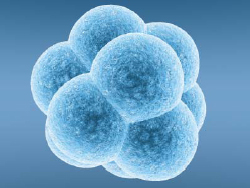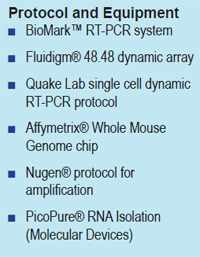早期胚胎發(fā)育中的單胚胎細(xì)胞基因表達(dá)
Single-embryo Gene Expression for Early Embryo Development
Mylene Yao, M.D. Assistant Professor
Dept. of Obstetrics and Gynecology Stanford University
Mylene Yao, M.D., and fellow Stanford University researchers found that Oct4, the master regulator of embryonic stem cell pluripotency, also has critical functions during reprogramming of the early mammalian embryo. This research may ultimately lead to improvements in human in vitro fertilization methods and is relevant to stem cell and cancer research.
They recently published their findings in a research paper entitled, A Novel and Critical Role for Oct4 as a Regulator of the Maternal-Embryonic Transition, available at http://www.ncbi.nlm.nih.gov/pubmed/19129941.
“Scientists from around the world are looking at how to reprogram a highly differentiated somatic cell into a pluripotent embryonic stem cell-like cell,” Dr. Yao said. “There are many different approaches with up and down sides to each; such as, how do you do this without causing side effects like cancer and how can you apply it to therapeutics? The question we ask is very different. We think the mouse, or human embryo, is a good model to study reprogramming because this is the only situation in nature where you have highly specialized cell types—the egg and sperm—that fuse together to undergo reprogramming to produce a pluripotent cell, that is capable of differentiating into many cell types.”

The Stanford scientists focused their efforts on the reprogramming mechanisms used by the embryo that direct how pluripotency or totipotency is established. They picked the well-studied Oct4 gene for its known reprogramming functions and because it is highly expressed in the oocyte and early one- to two-cell embryo stage.
“We microinjected specific antisense morpholino oligonucleotides (morpholinos) to knock down the [Oct4] gene,” Dr. Yao said. “This is a well established approach in other model organisms but not so much in the mouse. So we had to establish the protocols and the controls and it turned out to be a powerful technique. We were able to get very specific gene knockdown and highly reproducible results.”
Their first finding was that Oct4 has a critical function prior to the blastocyst stage.
“That finding was new and we were very excited about it,”Dr. genes showing less inter-embryo variation are more tightly controlled… and we believe that these genes are very important in the gene network. What’s interesting is when we ranked them, the top two genes with the least amount of inter-embryo variation were Rest and Mta2. These genes were just reported to have important pluripotency functions in embryonic stem cells*. Mta2 is also implicated in human breast cancer. So it’s really exciting. Not only were we able to validate the gene chips results, but the BioMark helps us prioritize the genes for further study.”
The Research Experiment
To find out what the Oct4 pluripotency regulator does at the one- to two-cell stage, the researchers did gene chip experiments on the Affymetrix whole mouse genome chip and then Fluidigm’s Bio-Mark™ System for Gene Expression Analysis.

The researchers ran a total of three independent experiments, each with an Oct4 knockdown sample and an uninjected sample. Each sample was derived from 20 embryos pooled together. Following RNA extraction using the PicoPure kit (Molecular Devices, they amplified half the pooled embryo sample with the Nugen Pico Ovation kit to prepare the samples for gene chip experiments. They repeated these steps for another three pairs of samples comprising cyclin A2 knockdown embryos and uninjected controls, as a positive control.

“We picked 42 genes to validate on the BioMark system,” Dr. Yao said. “We picked them to represent different functional categories.”
“We used the Fluidigm 48.48 dynamic array to validate differential gene expression between knockdown and control samples,” Dr. Yao explained.
Of the 42 genes, three were removed from the study due to technical difficulties, but expression changes of 39 of the genes were measured. Of those, 87% showed altered expression due to the Oct 4 knockdown. “We were very happy to be able to validate our results,” Dr. Yao said. “That level of scrutiny is very important for a strategy that is not widely used in the mouse model.”
Prior to using the BioMark highthroughput system, which can test as little material as a single cell against 96 genes, the group used conventional RT-PCR practices.
"Our single-embryo data allowed us to go beyond simply validating our gene chip data,” the researchers wrote in their paper. “Methods using samples comprised of pooled cells or embryos, generate relative gene expression that represents an average of all cells assayed, but they cannot discern between genes that are consistently differentially regulated versus those with a tendency towards stochastic changes; similarly, rare outlier embryos expressing unique transcriptomes are not recognized. By analyzing quantitative expression data at the single-embryo level, we were able to make this discrimination.”
Dr. Yao said prior to using the BioMark system, they only tested three genes from pooled samples. “In the conventional system, we would have to pool, say 10 embryos per sample to test two to three genes, and for genes not highly expressed, we’d have to pool 20. Semi qPCR is able to do it, but to see differential expression levels that are statistically significant, you’d have to repeat the experiment many more times or you’d have to pool many more samples.” Dr. Yao said the time savings in using the BioMark system was significant.
"What we accomplished on the BioMark system in three weeks would take a similarly skilled and dedicated researcher more than nine months to accomplish,” she said.
Possible Medical Application of Results
Dr. Yao said studying embryo development in mice, may ultimately help improve in vitro fertilization methods for treating human infertility.
"In clinical infertility, we don’t understand why some couples have trouble conceiving,” she said. “According to the diagnostic tests we have available, about 10-30% don’t have a cause that can be identifi ed.
Many embryos that are cultured do not make it to the eight-cell stage by day three, or the blastocyst stage. We don’t know if it is something inherent in thecouples or if the problem is that
in vitro fertilization methods are not really suited to culturing some human embryos.”
Dr. Yao explained that it is technically not feasible to do gene chip analysis on human embryos and it is good to first understand the mouse system to see if we can understand what genes are critical for the embryo development process, and to use that knowledge to investigate clinical infertility.
Further Embryo Research Planned
Dr. Yao and her fellow researchers are now looking at the mouse embryo development at the multicell stage, by which time ~90% of Oct4 knockdown embryos have arrested in development.
“We’re going to do gene chip experiments at the other stages and use the BioMark to validate results and further deconstruct the gene network.”
Biography
Mylene W. M. Yao is assistant professor and clinician-scientist in obstetrics and gynecology, reproductive endocrinology and infertility, and reproductive biology. Dr. Yao graduated from medical school at University of Toronto in 1993, and completed her obstetrics and gynecology residency training at McGill University in 1998. She received her clinical subspecialty training in reproductive endocrinology and infertility at Brigham and Women’s Hospital, Harvard University, from 1998-2001. During that time, she also trained in developmental biology as post-doctoral fellow in the laboratory of Richard L. Maas, M.D., Ph.D. After a brief time as assistant professor at Columbia University, she moved to Stanford University in 2003 to initiate her independent research on mammalian embryo development.
Research Summary
We are interested to understand how the early mammalian embryo is reprogrammed to establish totipotent or pluripotent blastomeres, which subsequently undergo lineage-specific differentiation to give rise to all the cell types in the organism. Specifically, we aim to understand how key processes such as nuclear reprogramming, establishment of developmental competence, maintenance of pluripotency, and cell fate decisions are regulated at the earliest stages of mouse and human development. These questions are especially intriguing and relevant to medicine because the zygote, or one-cell stage embryo, are formed by the fusion of the sperm and egg, which are arguably the most differentiated cell types, as they only host haploid genomes. This natural process of reprogramming is relatively efficient, quick and safe from oncogenic potential. Thus, the early pre-blastocyst stages hold the key to Nature’s reprogramming toolkit, which is invaluable to our efforts in developing stem cell-based therapies. We have taken innovative approaches to establish both in vitro and in vivo human and mouse models, to identify the genetic and physical determinants that are critical and sufficient for optimal development. Our methods include gene knockdown strategy combined with single-embryo gene expression profi ling, applying microfluidics to control physical culture parameters, and the use of clinical in vitro fertilization (IVF) outcomes analysis to direct us towards clinically relevant embryo and reproductive phenotypes. We discovered novel and critical roles of master pluripotency regulator, Oct4, in the maternal-embryonic transition, and have begun to deconstruct the gene regulatory network in the early embryo. Combined with deep phenotyping efforts in early human embryo development and clinical IVF, we are investigating early human development in a translational context that is directly relevant to human health and disease. Our mission is to contribute new and essential knowledge to advance paradigms in the fields of stem cell, cancer, and assisted reproductive technologies, and broaden our scope of human development, health and disease in the 21st century.
原文下載:http://www.fluidigm.com/pdf/fldm/FLDM_MRKT00117.pdf
References and Related Links
Foygel, K., Choi, B., Jun, S., et al., 2008 Dec 31. A Novel and Critical Role for Oct4 as a Regulator of the Maternal-Embryonic Transition. PLoS ONE.3(12): e4109. http://www.ncbi.nlm.nih.gov/pubmed/19129941
Singh SK, Kagalwala MN, Parker-Thornburg J, Adams H, Majumder S (2008) REST maintains self-renewal and pluripotency of embryonic stem cells. Nature 453: 223-227. www.time.com; “Predicting In Vitro Success” by Alice Park; July 1, 2008: http://www.time.com/time/health/article/0,8599,1819524,00.html
National Public Radio, “Predicting In Vitro Success Made Easier” by Joe Palca in All Things Considered; aired July 3, 2008: http://www.npr.org/templates/story/story.php?storyId=92204512
Reuters; New method may help predict IVF success: study by Julie Steenhuysen: http://www.reuters.com/article/scienceNews/idUSN0125903720080702
The Guardian; “Fertility: Doctors find test to predict chances of IVF success” by Ian Sample; July 2, 2008: http://www.guardian.co.uk/science/2008/jul/02/medicalresearch.health
U.S. News & World Report; “New Method Better Predictor of In Vitro Fertilization Success”; July 1, 2008: http://health.usnews.com/articles/health/healthday/2008/07/01/new-method-better-predictor-of-in-vitro.html
Dr. Yao’s home page http://womenshealth.stanford.edu/research/yao.html
- LongGene熒光定量PCR助力中科大團(tuán)隊(duì)榮登Nature子刊
- 熒光定量 PCR 中無 Ct 值或 Ct 值過晚,該如何解決?
- PCRqPCR擴(kuò)增應(yīng)用方案
- 多重qPCR核心特點(diǎn)、優(yōu)勢(shì)及應(yīng)用領(lǐng)域的介紹
- 通過PCR反應(yīng)程序優(yōu)化對(duì)反應(yīng)時(shí)長進(jìn)行極致壓縮
- QT30三槽熒光定量PCR儀的性能優(yōu)勢(shì)和應(yīng)用場(chǎng)景
- 實(shí)時(shí)熒光定量PCR反應(yīng)體系中熒光信號(hào)物質(zhì)使用染料法及探針法的區(qū)別
- 實(shí)時(shí)熒光定量PCR儀Q9600操作指南之程序模板設(shè)置
- 杰萊美邀您共赴中國昆蟲學(xué)會(huì)昆蟲分類區(qū)系學(xué)術(shù)研討會(huì)
- 柏恒科技618狂歡:采購指定實(shí)驗(yàn)設(shè)備獲贈(zèng)配套裝備
- 柏恒科技邀您參加2025第六屆國際獸醫(yī)檢測(cè)診斷大會(huì)
- 尚睿生物推出“會(huì)員專享套餐”,加盟會(huì)員試劑免費(fèi)用
- 柏恒科技攜定量PCR儀等多款儀器亮相俄羅斯實(shí)驗(yàn)室展
- 柏恒科技2025年3月質(zhì)量月活動(dòng)總結(jié)會(huì)議圓滿落幕
- 科技賦能,智啟未來 ——艾普拜生物亮相南京科教展
- 柏恒科技攜PCR儀等分子生物學(xué)產(chǎn)品閃耀CACLP 2025





